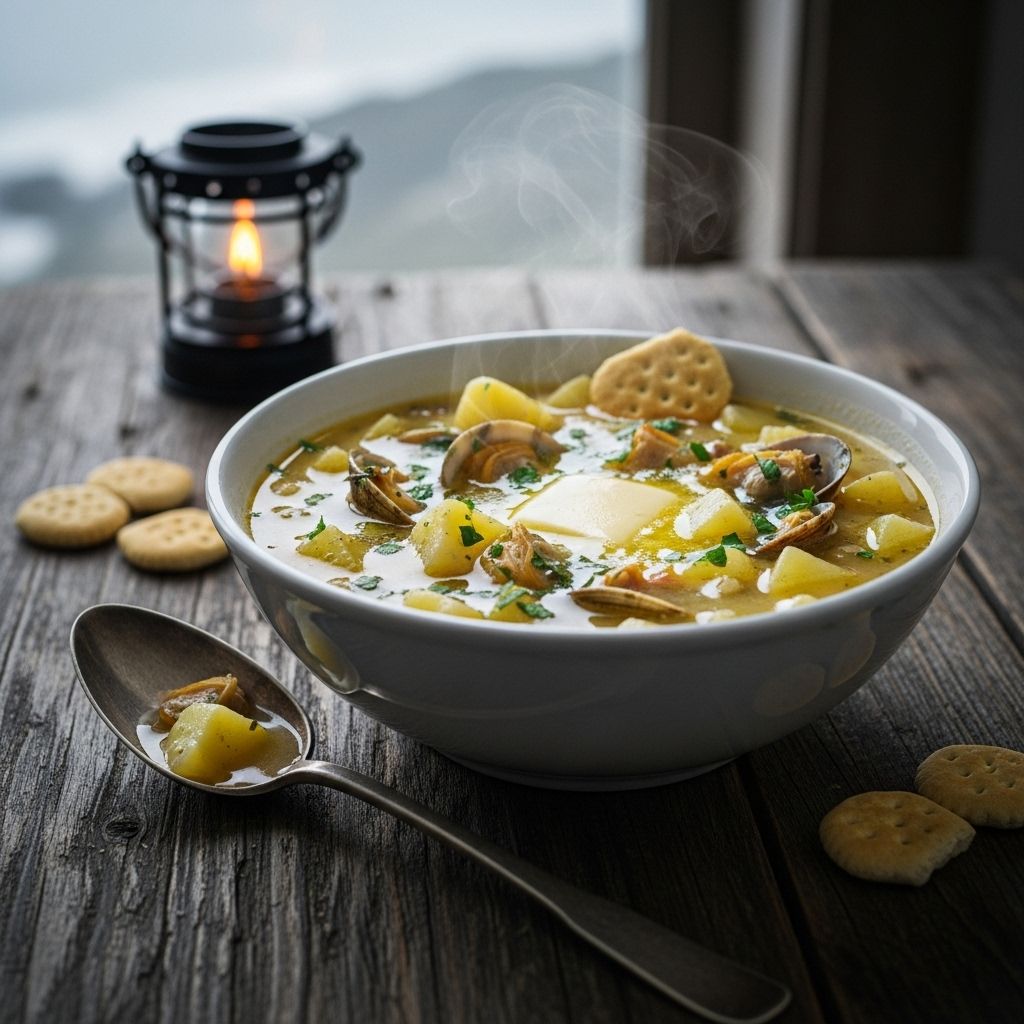Classic New England Clam Chowder: Creamy Tradition in Every Spoonful
A harmony of smoky bacon, tender potatoes, and silky broth delivers ultimate comfort.

Image: HearthJunction Design Team
Classic New England Clam Chowder
New England clam chowder stands as a culinary icon of the northeastern United States—a dish celebrated for its creamy broth, tender potatoes, briny clams, and smoky bacon. Rooted deeply in regional tradition, this soup is a staple in seaside towns and upscale restaurants alike. Whether enjoyed on a chilly coastal evening or as the centerpiece of a comforting family meal, New England clam chowder combines simple ingredients for a result that is both luxurious and incredibly satisfying.
What Is New England Clam Chowder?
New England clam chowder is a creamy soup featuring clams as the star ingredient. This chowder is distinguished by its rich, milk- or cream-based broth (unlike the tomato-based Manhattan style), the inclusion of potatoes, onions, and, often, bacon or salt pork. Each spoonful delivers a perfect balance of land and sea, underscored by subtle herbal notes and the unmistakable flavor of fresh shellfish.
Known for its thick, velvety texture and hearty, satisfying nature, New England clam chowder is the definition of northeastern comfort food.
Essential Ingredients
To create an authentic bowl of New England clam chowder, it’s important to use the right ingredients in the right proportions. Here’s what you’ll need:
- Clams: Chopped or minced clams are the backbone of the chowder, providing briny, oceanic flavor. Canned clams are common and convenient, but fresh clams deliver unbeatable freshness.
- Bacon: Adds a rich, smoky depth to the soup. Bacon is sautéed at the start, and its rendered fat is used to soften the vegetables.
- Onion: Chopped onions lend sweetness and aromatic base notes to the chowder.
- Potatoes: Diced potatoes offer body and texture, absorbing flavors as they cook in the broth.
- Clam Juice: Reserved from canned clams (or bottled), clam juice intensifies the seafood flavor throughout the soup.
- Butter & Flour: Combined to make a roux, these thicken the broth to the signature creamy consistency.
- Cream or Milk: Full-fat milk or light cream gives the chowder its signature richness and smoothness.
- Salt & Pepper: To taste, highlighting and balancing all other flavors.
Optional Additions
- Celery for added crunch and aromatic balance.
- Parsley or other fresh herbs for garnishing.
- Carrots for a touch of sweetness (though not traditional).
- Red wine vinegar for a subtle boost of acidity.
Step-by-Step Preparation Guide
Making New England clam chowder at home is easier than you might expect. Follow these steps for chowder success every time:
- Render the bacon: In a large pot or Dutch oven, cook diced bacon over medium heat until crisp. Remove the bacon with a slotted spoon and set aside, leaving the rendered fat in the pot for sautéing.
- Sauté the aromatics: Add chopped onion (and optional celery) to the bacon fat. Cook until softened and translucent, stirring occasionally to prevent browning.
- Add potatoes and clam juice: Stir diced potatoes into the pot and pour in the reserved clam juice. Simmer until potatoes are tender—usually about 10–15 minutes.
- Make a roux: In a separate saucepan, melt butter over medium heat. Whisk in flour, forming a thick paste. Gradually whisk in milk or cream to avoid lumps, cooking until the mixture begins to thicken.
- Combine and simmer: Pour the milk mixture into the potato and clam juice base. Stir to blend and return to a gentle simmer, allowing the flavors to meld.
- Add clams and bacon: Stir chopped clams and reserved bacon into the chowder. Heat gently—do not boil, as overcooked clams can become tough.
- Season and finish: Taste and adjust seasoning with salt and pepper. Add a splash of red wine vinegar for brightness, if desired.
Tips for the Best Chowder
- Simmer, never boil: Once you add the dairy, keep the heat low to avoid curdling.
- Use thick-cut bacon: For meatier bites and richer flavor.
- Cut potatoes evenly: Uniform size ensures even cooking and a pleasing texture.
- Do not overcook clams: Add at the end and heat just until warmed.
- Fresh herbs: Finish with fresh parsley or chives for a vibrant touch.
How to Thicken Your Chowder
Although the classic roux ensures a creamy base, you can make your chowder thicker by:
- Adding more flour to the butter when making the roux.
- Simmering longer to reduce the liquid.
- Mixing a cornstarch slurry (1 tablespoon cornstarch to 2 tablespoons cold water) and stirring it in at the end until the desired thickness is achieved.
Serving Suggestions
New England clam chowder is delicious on its own but becomes a memorable meal when paired with classic sides:
- Oyster crackers: The traditional crunchy accompaniment.
- Crusty sourdough bread: Perfect for sopping up creamy broth.
- Fresh salad: To balance the richness of the soup.
- Chopped herbs or cracked black pepper: For garnishing before serving.
Storage and Make-Ahead Tips
Chowder often tastes even better the next day as flavors meld. Here’s how to store and reheat:
- Refrigerate cooled chowder: Store in an airtight container for up to 3 days.
- Reheat gently: Warm over low heat, stirring to prevent scorching or separation of dairy. Avoid boiling.
- Freezing not recommended: Dairy-based chowder can separate or become grainy when frozen and thawed.
Ingredient Variations and Substitutions
| Ingredient | Substitution Option | Flavor Impact |
|---|---|---|
| Clams | Canned, fresh, or frozen | Fresh provides cleanest briny taste; canned is convenient |
| Bacon | Salt pork or pancetta | Pancetta is less smoky, salt pork more traditional |
| Milk/Cream | Half-and-half, evaporated milk | Half-and-half lighter; evaporated milk rich but shelf-stable |
| Potatoes | Yukon Gold, Red Bliss | Yukon Golds are buttery; Red Bliss hold shape well |
Nutritional Overview
Clam chowder is naturally high in protein and flavor but can also be rich in calories and fat due to the cream and bacon. Using milk instead of cream or reducing the amount of bacon can lighten the dish. Potatoes provide fiber and vitamins, while clams are a good source of iron and omega-3 fatty acids.
Frequently Asked Questions (FAQs)
Q: Can I use fresh clams instead of canned?
A: Absolutely. Steam fresh clams, remove them from shells, and reserve both the cooked clams and their cooking liquid to use in the chowder. This gives the freshest, most robust flavor.
Q: How do I prevent my chowder from curdling?
A: Avoid boiling once dairy is added. Always simmer gently and stir often to maintain a silky texture.
Q: Is it possible to make this chowder gluten-free?
A: Yes, substitute the all-purpose flour with a gluten-free flour blend or use cornstarch as a thickener.
Q: Can I prepare clam chowder ahead of time?
A: Yes, chowder can be made a day in advance. Flavors develop more deeply after resting overnight in the refrigerator. Reheat slowly over low heat before serving.
Q: What’s the difference between New England and Manhattan clam chowder?
A: New England clam chowder uses a creamy, dairy-based broth, while Manhattan chowder features a tomato-based broth and typically omits dairy entirely.
Expert Tips for Authentic Results
- Use the right ratio of dairy to broth for a chowder that’s creamy but not overly thick.
- Don’t rush the sautéing step: Properly softened onions and celery develop deeper flavor.
- Add bacon at the end for texture and to preserve its smoky crunch as a topping.
- For a richer flavor, simmer the potatoes with a bay leaf and a sprig of fresh thyme; remove before finishing the soup.
- Serve in bread bowls for an impressive presentation at gatherings or special dinners.
History and Cultural Context
New England clam chowder has been a beloved staple since the 18th century, evolving over time to become the creamy classic known today. Originally prepared along the coasts of Massachusetts and Maine, it quickly gained popularity thanks to the region’s abundant shellfish and dairy farms. Today, it is not only a comfort dish but also a symbol of New England cuisine, celebrated in festivals and restaurants throughout the Northeast.
Conclusion
Few soups match the heartwarming comfort and rich flavors of classic New England clam chowder. Using simple techniques and quality ingredients, you can recreate this celebrated dish in your own kitchen—perfect for sharing with friends and family on a crisp evening or as a soul-satisfying meal anytime. Enjoy each spoonful of creamy, smoky, oceany delight!
References
- https://www.allrecipes.com/recipe/13041/my-best-clam-chowder/
- https://www.allrecipes.com/recipe/245879/new-england-clam-chowder-for-two/
- https://www.allrecipes.com/recipe/228061/new-england-style-clam-chowder/
- https://www.allrecipes.com/recipe/13078/new-england-clam-chowder-i/
- https://www.allrecipes.com/recipe/25683/new-england-clam-chowder-iii/
Read full bio of Anjali Sayee












